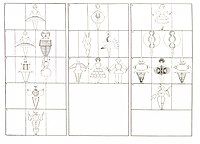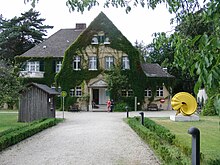Lou Scheper-Berkenkamp
Lou Scheper-Berkenkamp (born May 15, 1901 in Wesel as Hermine Luise Berkenkamp , † April 11, 1976 in Berlin ) was a German painter , color designer , avant-garde children's book author, fairy tale book illustrator and costume designer
Life
Lou Scheper-Berkenkamp was born on May 15, 1901, as the daughter of Adalbert Berkenkamp (1868-1947) and his wife Laura Johanna Katharina Darmstädter (1872-1956). She had two brothers Alfred (1896-1917) and Walter (1910-1994). Her father, together with his brother, her uncle Heinrich, ran the paper goods and bag factory in Wesel . Grandfather Heinrich Berkenkamp founded the company in 1865.
The school and its discovery
She graduated from the elementary school and attended connect four years, a high school . Lou also attended the Victoria School in Essen , a girls' high school with progressive teaching. The art teacher Margarete Schall (1896–1939) discovered her talent for colors and painting.
“In the Abitur certificate of March 4, 1920, 'her pronounced talent for literary and artistic problems' finds positive recognition. Likewise, her 'very good performance in German and in drawing' is confirmed. Talents that shaped her future path in life. "
The Bauhaus era

After graduating from high school in 1920 , Lou Berkenkamp enrolled at the Bauhaus in Weimar and took lessons from Johannes Itten , Lyonel Feininger , Paul Klee and Georg Muche . After she had passed the compulsory preliminary course, she switched to the mural painting workshop. In 1922 Berkenkamp left the Bauhaus together with Hinnerk Scheper , a fellow student from the Bauhaus, and married him on December 24 of the same year. During the first years of their marriage, Berkenkamp lived with their parents in Wesel with their son Jan Gisbert, who was born in November 1923 . The first drawings and illustrated letters were made during this time. Hinnerk Scheper meanwhile worked as a color designer in various places. In 1925 he was appointed master of wall painting at the Bauhaus in Dessau . In 1926 their daughter Britta was born in Dessau. After Georg Muche, master of wood carving, left for Berlin in 1927, a semi-detached house in a master's house was vacated and the Scheper family were able to move in there. Lou Scheper-Berkenkamp worked - without matriculation - in the stage workshop of the Bauhaus under the direction of Oskar Schlemmer . Lou supported an important area in Schlemmer's work with the development of costumes, choreographies, backdrops and puppets for “ Triadic Ballet ” (first performance in 1922 in Stuttgart , further development by Oakar in 1926 with music by Hindemith ). Among other things, she designed and directed costumes and backdrops for the plays Ojdar and Circus . From 1927 to 1929 she took part in the collective exhibitions of the Bauhaus.
Figurines of the Triadic Ballet in the Staatsgalerie Stuttgart
The time in Moscow
From July 1929 to August 1930 the Schepers followed a call to Moscow. As a specialist in color design, Hinnerk Scheper was supposed to set up an “advice center for color in architecture and the cityscape” (in Russian Maljarstroj) for the entire Soviet Union . Together they worked on the color plans. During this time Lou Scheper-Berkenkamp wrote articles for the German-language weekly magazine Moskauer Rundschau . In her contributions she recorded the everyday life of people in the big city with an artistic hand and socially critical. In the service of her husband she did not publish any of her own works in Moscow and supported Hinnerk with organizational problems. Inspired by the figures of the Triadic Ballet, collages were created with the basic shapes of circles, triangles and squares. With her abstract work, she was critical of the standardization of architecture and the Soviet citizens. She painted Moscow's street life with ink and opaque colors. This is how ironic texts and skilful images were created.
"The Soviet star has by no means blinded us."
The time of National Socialism
After another short stay in Moscow in 1931, the Schepers returned to the Bauhaus in Dessau under the new director Ludwig Mies van der Rohe . When the Bauhaus moved in 1932, they also moved to the capital Berlin.
“Light-clear and dark-clear tones, pure white and pure black, varied shades of gray without pollution - that was the color world into which the bad brown and the fiery red of the Third Reich broke into. What was before 1934 was buried and has to laboriously brought to light again, brought to consciousness. "
Due to the worsening political situation in Germany in 1932, further cooperation with the Soviet colleagues was no longer possible. The right-wing magistrate in Dessau, the leading parliamentary group in the city council since 1931, cut back all financial resources for the Bauhaus. On October 1, 1932, the Dessau Bauhaus closed involuntarily and under high political pressure. It was used as a Gauführerschule of the NSDAP . Mies van der Rohe wanted to continue the Bauhaus in Berlin under the title “Free Teaching and Research Institute” in the former Steglitz telephone factory with his own funds , but the fascists forced him to close the institute on July 20, 1933. From then on the teachers had to make a living by doing odd jobs. Some Bauhaus artists emigrated to Palestine and the USA .
"There are two ways to react to a catastrophe: one gets beside oneself or one gets into oneself."
Since the closure of the Berlin Bauhaus in 1933, Lou Scheper-Berkenkamp worked as a freelance painter in Berlin. Their son Dirk was born in Berlin in 1938. Lou accompanied Hinnerk on his “North German Reportage Journeys” and wrote texts for his various landscape photo series. Repressions in 1934 against her husband Hinnerk, who was banned from joining the Reich Association of German Photo Reporters by the Nazis , also dried up this source of income for the family. So they concentrated on the color design of public houses, murals and restoration work. From 1942 to 1945 Scheper did military service in Germany. Lou took care of the family alone during this time. She invented picture stories, which were not published as children's books until 1948 by the Ernst Wunderlich Verlag in Leipzig . The family survived the war years in complete seclusion.
The time after the Second World War
Lou Scheper-Berkenkamp, with her children Britta, Jan Giesbert, Dirk and their parents, whose house in Wesel was destroyed by the war, experienced the end of the war in Badbergen. In 1945, Hinnerk Scheper was appointed by the Berlin magistrate to be a monument curator and state curator of Berlin, and his wife supported him in his work.
The new beginning of the poet painter
From now on she devoted herself to her artistic work and looked for a way to publish children's books . In the publisher Ernst Wunderlich from Leipzig she found the right contact, with the best technical possibilities of offset printing and an admirer of her art.
"" I hope that the joint work we are starting to do together will serve the cause of children's books, that we will succeed in gaining friends for your work and that the peculiar and artistically attractive creations of your hand will be most happily received by the children's audience [...]. ""
“That wasn't the usual world of elves and dwarves. The teddy bears and Easter bunnies, but an exciting new, bold and cheerful, playful and generous world. […] These picture books are bursting with life and movement […]. written by a "poet painter" who created a unity from text and image. "
In 1950/51 she took part in “exhibitions of picture book originals”. Her works were shown in “ America Houses ” in Kassel , Darmstadt , Frankfurt , Gießen , Marburg and Wiesbaden . These American institutions emerged in West Germany around 1950 in the spirit of democratic educational work by the Allies. In the open, friendly atmosphere of these houses, Lou's timelessly artistic picture stories unfold the narrative flow of her art.
"Der Ring" 1951 Artists' Association Berlin Exhibitions and new projects
In 1951 Lou Scheper-Berkenkamp was one of the founders of the Berlin artists' association "Der Ring", to which she was a member of the board until 1970. Members included Erhard Groß (1926– 2011 Berlin) , Wilhelm Peter August Helmstedt (born September 3, 1904 in Wilhelmshaven; † March 10, 1976 in Berlin), Arno Mohr , Arthur Fauser , Peter Steinforth , Alfred Kubin , Wolf Röhricht , Siegmund Lympasik , Ulrich Knispel , Otto Eglau , Erich Waske , Georg (Gory) von Stryk (* August 30, Dorpat ; † December 14, Berlin), Walter Wellenstein (* May 21, 1898 Dortmund; † October 17, 1970 Berlin), Erich Fritz Reuter , Gerhart Schreiter and Hans Szym . She exhibited with her artist colleagues for several years in the " Haus am Waldsee " in Berlin-Zehlendorf . In addition to taking part in numerous exhibitions in Germany and in some cases abroad, Lou Scheper-Berkenkamp was still actively involved in the professional association of visual artists in Berlin until 1970 . Between 1956 and 1969 she was jointly responsible for the design of the annual Great Berlin Art Exhibition . After Hinnerk Scheper's death in 1957, Lou Scheper-Berkenkamp took over his duties in the field of color design in Berlin's architectural landscape. Among other things, she was responsible for the color design of the interiors of the last project realized by Otto Bartning , a Berlin children's home, the Berlin Philharmonie by Hans Scharoun , the Egyptian Museum , various buildings by Walter Gropius in Berlin Britz-Buckow-Rudow and the Berlin Tegel airport building involved. Until her death on April 11, 1976, Lou Scheper-Berkenkamp was still working on the color concepts for Scharoun's Berlin State Library .
“There is little in the architecture and art of our time that was not felt, formulated, anticipated in the Bauhaus, even if it rarely seems to be brought to an end, not even always thought through. A fragment, without a doubt, this our now legendary Bauhaus, transfigured by the charm of the unfinished. "
Lou Scheper-Berkenkamp died on April 11, 1976 in Berlin; the couple's grave is located in the Zehlendorf cemetery .
Scheper family
On December 22, 1922 she married her husband Hinnerk (Gerhard Hermann Heinrich) in the city church of St. Peter and Paul in Weimar .
The following children were born from the marriage:
- Jan Gisbert (born November 7, 1923)
- Britta (born March 28, 1926 - † January 14, 2012)
- Dirk (born August 21, 1938)
Her daughter-in-law became the wife of son Dirk, Renate Scheper.
Own literary works
- Lou Scheper-Berkenkamp art exhibition May-June 1948 ; State Rudolstadt Castle Museum Author: Lou Scheper-Berkenkamp; Publisher: Rudolstadt Heidecksburg Directorate of the State Castle Museum 1948
- Lou Scheper: experienced and helped shape - from the bauhaus to today. In: I point COLOR. Düsseldorf 3/1964.
- Scheper, Lou: Review. In: Neumann, Eckhard (ed.): Bauhaus and Bauhäusler. Memories and confessions. Dumont paperbacks. Cologne: DuMont 1985 (EA Bern, Stuttgart 1971).
- The Narkomfin Commune House in Moscow, 1928–2012: Dom Narkomfina (Russian Дом Наркомфина) - the house of the People's Commissariat for Finance: and the ICOMOS - ISC 20C - Madrid Document 2011 Author: Moissei Jakowlewitsch Ginsburg ; Hinnerk Scheper; Lou Scheper-Berkenkamp; Johannes Cramer; Anke Zalivako; et al
- Fantastics: the Bauhaus student Lou Scheper-Berkenkamp Authors: Lou Scheper-Berkenkamp; Annemarie Jaeggi; Edzard Reuter; Dirk Scheper; Renate Scheper; All authors Verlag Bramsche: Rasch, 2012.
- Ways to Preserve the Architectural Heritage of the 20th Century Author: M IA. Ginzburg; Hinnerk Scheper; Lou Scheper-Berkenkamp; Johannes Cramer ; Anke Zalivako; et al Published by Petersberg: Michael Imhof , cop. 2013.
Photo letters Lou Scheper to Marie-Luise Betlheim 1922–1936
- Photo letters: Bauhaus student Lou Scheper to Marie-Luise Betlheim: Weimar, Dessau, Berlin, 1922–1936 = (Croatian Ilustrirana pisma: Baushausovka Lou Scheper za Marie-Luise Betlheim: Weimar, Dessau, Berlin, 1922-1936 . Author: Lou Scheper -Berkenkamp) Publisher: Zagreb : UPI2M PLUS and Museum of Contemporary Art, 2015.
- Map of the illustrated letters from Lou Scheper to Marie-Luise Betlheim (Croatian Mapa ilustriranih pisama Lou Scheper za Marie-Luise Betlheim ) Author: Korana Sutlić Objavljeno (Published): 06/10/2015 at 7:18 am
Published picture books
- Tots, a very small thing . Leipzig : Ernst Wunderlich 1. – 25. Ts. 1948. Six-color offset print , 16 p. 10.5 × 14.8 cm. Stapled. Reprint: Berlin: Bauhaus Archive 2012.
- Lenchen doll . Leipzig: Ernst Wunderlich 1. – 25. Ts. 1948. Six-color offset print, 16 p. 10.5 × 14.8 cm. Stapled. Reprint: Berlin: Bauhaus Archive 2012.
- Barrels, buttons and others . Leipzig: Ernst Wunderlich 1948. Six-color offset print, 12 p. 10.5 × 14.8 cm. Stapled.
- The stories of Jan and Jon and their pilot fish. Leipzig: Ernst Wunderlich 1948. Eight-color offset print, 20 p. 29.7 × 21 cm. Boxed
Unpublished children's book manuscripts
- Bälkchen tells its story. 1948 . Edition 15,000. Liz. No. 154.20 p. 29.7 × 21 cm (announced “In preparation”).
- The serious story of the expelled and reconciled stars . For children from 8-14 years of age and for their parents if they are not yet too grown up. Printing permission from the Cultural Advisory Board for Publishing from April 1948. Edition 20,000. 48 p. 29.7 × 21 cm (announced “In preparation”).
- The blotter children and their dog. 16 pp. (Announced 1948).
- Blümchen's adventure, a whimsical story. 14 pp. (Announced 1948).
- The story of the vain little girl (designed around 1949).
- Strange journey of a little girl named Tüttchen and an unnamed but golden church tower cock (designed around 1949).
- Carnival (designed around 1949).
- The story of a child's last dream (designed around 1949)
literature
- Dirk Scheper: Biographical information on the life of Lou Scheper-Berkenkamp , Berlin 1987, Bauhaus-Archiv Berlin
- Ulrike Müller: Bauhaus women. Masters in art, craft and design, Munich 2009
- Barbara Murken: "Actually, I prefer to sit on air lines than on armchairs ..." The magical world of images by Bauhaus artist Lou Scheper-Berkenkamp , in: Das Bücherschloss. Messages from the International Youth Library 2009, Munich 2010, pp. 77–84
- Bauhaus Archive Berlin / Museum of Design, Fantastics: The Bauhausler Lou Scheper-Berkenkamp , Berlin 2012
- Lou Scheper-Berkenkamp . In: Elizabeth Otto , Patrick Rösler (ed.): Women at the Bauhaus. Pioneering modern artists. Knesebeck, Munich 2019. ISBN 978-3-95728-230-9 . Pp. 44-45.
- Lou Scheper-Berkenkamp. Catalog of the Staatl. Rudolstadt Castle Museum. Text: Suse Wintgen. Rudolstadt 1948.
- Detlef Hoffmann: doll story. In: Doderer, Lexikon der Kinder- und Jugendliteratur , 1979, pp. 99-104.
- Bettina Hürlimann: European children's books in three centuries. Zurich, Freiburg: Atlantis 1959.
Web links
- Simone Orlik: Bauhaus women: icons of the second row. May 9, 2019, accessed May 11, 2020 .
- Bauhaus women - in the shadow of men. (Film; 43:40 min) In: www.youtube.com. rbb, June 20, 2019, accessed May 11, 2020 .
- Lou Scheper-Berkenkamp (1901-1976). In: www.bauhaus-bookshelf.org. Retrieved May 11, 2020 .
- Lou Scheper-Berkenkamp (1901-1976). In: www.bauhaus-bookshelf.org. Retrieved May 11, 2020 .
- http://bauhaus-online.de/atlas/haben/lou-scheper-berkenkamp (accessed on November 29, 2012)
- http://www.art-magazin.de/kunst/56974/lou_scheper_berkenkamp_berlin (accessed on November 29, 2012)
- Lou Scheper-Berkenkamp: 1920–1933 students at the Bauhaus. In: www.bauhaus100.de. Retrieved May 11, 2020 .
- Stefan Lüddemann: From the Bauhaus into the world of fantasy. In: www.bauhaus100.de. October 17, 2013, accessed May 11, 2020 .
- Oskar Schlemmer - The Triadic Ballet. (Excerpt from film; 6:58 min) In: www.youtube.com. December 17, 2013, accessed May 11, 2020 .
- Works by Lou Scheper-Berkenkamp, picture letters to Maria Rasch, her friend and Walter Gropius, illustrations https://www.design-is-fine.org/search/Lou+scheper (accessed April 30, 2020)
Individual evidence
- ↑ a b c d e Children's and Young People's Literature A Lexicon Edited by Kurt Franz and Franz Josef Payrhuber on behalf of the German Academy for Children's and Young People's Literature. e. V., Volkach Founded by Alfred Clemens Baumgärtner and Heinrich Pleticha. Co-edited by Günther Lange 1999 and 2015 (PDF on kinderbuchforschung-murken.de Lou and Hinnerk Scheper) Lou Scheper-Berkenkamp p. 1 and others (PDF view)
- ↑ Color Wheel after Johannes Itten von (Alias) KagoBelcol youtube.com color wheel
- ^ Scientific journal of the University of Architecture and Building Weimar, Volume 26, 1 1979 1 Issue 4/5 Larissa A. Shadowa Hinnerk Scheper and Boris Ender in Maljarstroj
- ↑ " Actually, I prefer to sit on air lines than on armchairs ... " The magical world of images by Bauhaus artist Lou Scheper-Berkenkamp by Barbara Murken, p. 81 (PDF, p. 8)
- ↑ Biographical information and works by Erhard Groß on berlin.museum-digital.de Erhard Groß Collection (FHXB Friedrichshain-Kreuzberg Museum)
- ↑ Biography and works of Wilhelm Peter August Helmstedt on art-archives-southafrica.ch gallery
- ↑ Short biography and works of Walter Wellenstein at www.art1900.de Vita and works of Walter Wellenstein
- ↑ Works by Hans Szyma on www.galerie-finckenstein.de 1951-1961 participation in art exhibitions of the ring
- ^ "The Ring" exhibition Haus am Waldsee 1954 on willgrohmann.de/zeitungs-archiv PDF
- ↑ The other side exhibition “The Ring” in the Hans am Waldsee Article Will Grohmann PDF
- ↑ On waz.trauer.de - created by Funke Mediengruppe, January 14, 2012 Britta Schöne-Warnefeld geb. Scheper
- ↑ On www.jutarnji.hr Photo letters Lou Scheper-Berkenkamp Photo letters from Lou Scheper-Berkenkamp to Marie-Luise Betlheim
- ↑ On www.jutarnji.hr Bildbriefe Lou Scheper-Berkenkamp The testimony to a friendship and the inimitable spirit of the Bauhaus (Croatian Svjedočanstvo jednog prijateljstva i neponovljivog duha Bauhausa )
- ↑ Art in the nursery ArtistPicturesBooks from all over the world [1]
| personal data | |
|---|---|
| SURNAME | Scheper-Berkenkamp, Lou |
| ALTERNATIVE NAMES | Berkenkamp, Hermine Luise (maiden name); Scheper-Berkenkamp, Hermine Luise (full name) |
| BRIEF DESCRIPTION | German painter, Bauhaus student and color designer |
| DATE OF BIRTH | May 15, 1901 |
| PLACE OF BIRTH | Wesel |
| DATE OF DEATH | April 11, 1976 |
| Place of death | Berlin |









